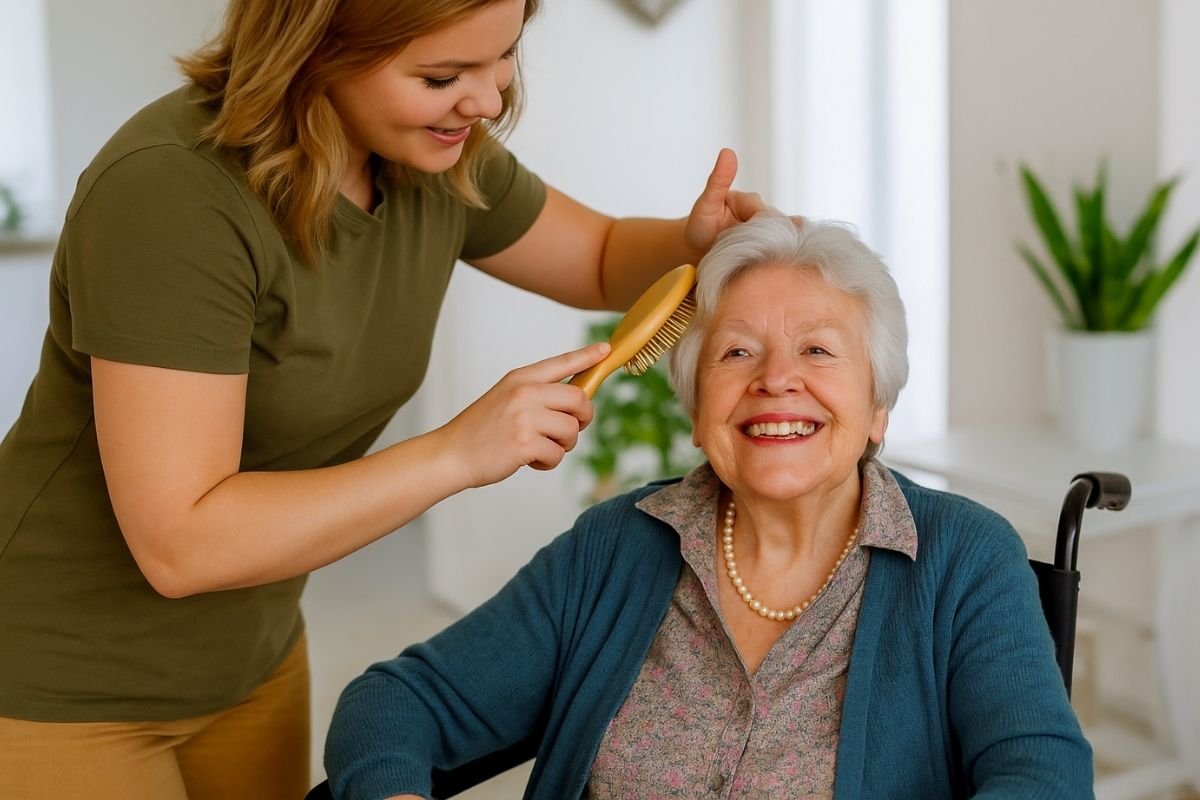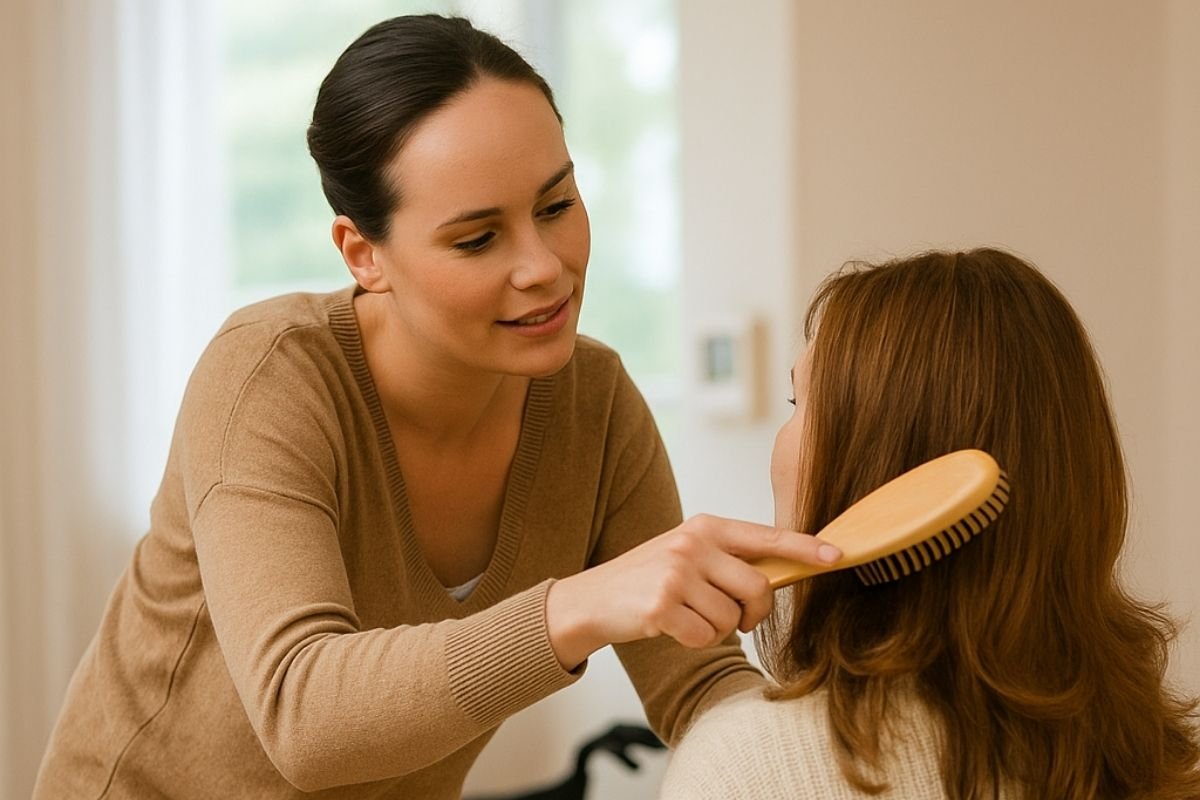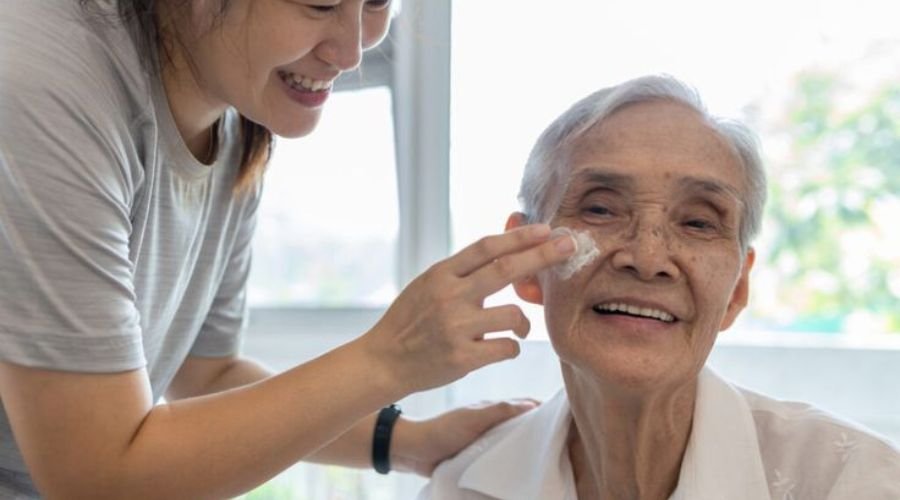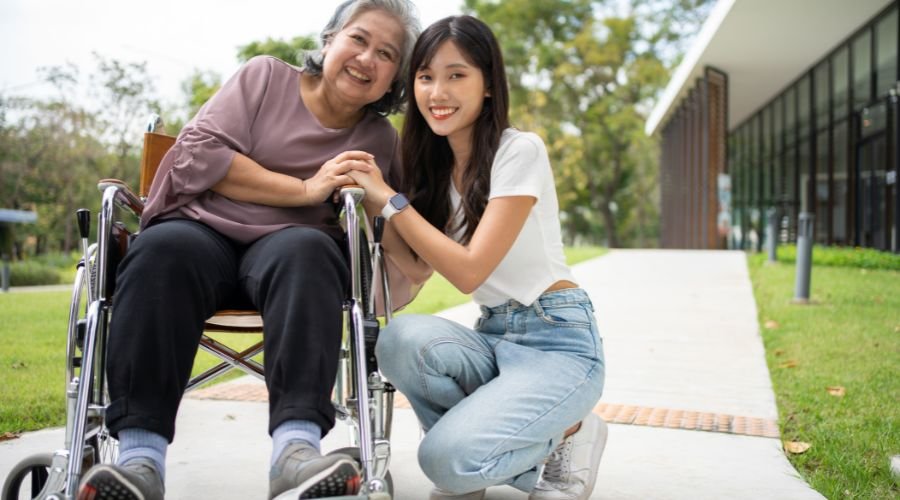Importance of Hair and Skin Care
Hair and skin care are essential components of personal hygiene and overall well-being, especially for individuals who rely on caregivers for daily assistance. Proper care not only prevents physical health issues but also promotes emotional and mental wellness.
1. Health Benefits of Hair and Skin Care
Caregivers play a pivotal role in maintaining the health of their clients’ skin and hair. Regular skin care helps prevent common issues such as dryness, pressure sores, and infections. For immobile individuals, this is particularly important as prolonged pressure on certain areas can lead to ulcers. Similarly, scalp care, including washing and brushing hair, reduces the risk of dandruff, lice infestations, and other scalp conditions. Hydration through moisturizers and gentle cleansing ensures the skin remains a strong barrier against germs and environmental damage.
2. Emotional and Psychological Impact
Beyond physical health, proper grooming significantly enhances self-esteem. Clean, well-groomed hair and healthy skin can boost confidence and provide a sense of normalcy. For many, these routines are comforting rituals that foster relaxation. Skincare practices also encourage mindfulness, allowing individuals to focus on the present moment, which can alleviate stress and anxiety.
3. Monitoring Changes in Health
Caregivers are often the first to notice subtle changes in skin or scalp health. Redness, irritation, or sores may indicate underlying issues requiring medical attention. By staying vigilant during grooming routines, caregivers can act as early detectors for potential health concerns.
Best Practices for Caregivers
- Use gentle products suitable for sensitive skin.
- Maintain a consistent routine to build trust and comfort.
- Ensure proper hydration by encouraging fluid intake.
- Document any changes in skin or hair condition for medical follow-up.
Incorporating hair and skin care into caregiving not only supports physical health but also nurtures emotional well-being, fostering a holistic approach to care.

Preparing for Hair and Skin Care Assistance
Effective hair and skin care assistance begins with thorough preparation to ensure the comfort, safety, and dignity of the individual receiving care. Proper planning allows caregivers to provide high-quality, personalized support while minimizing stress for both parties.
1. Assess the Client’s Needs
Understanding the unique requirements of the individual is essential. Begin by determining the level of assistance they need—whether full support, partial help, or just supervision. Review their care plan for specific instructions regarding sensitivities or existing conditions like eczema or psoriasis. This ensures that the products and techniques used are appropriate for their health needs.
2. Gather Necessary Supplies
Having all supplies ready beforehand helps streamline the process:
- For hair care: Include shampoo, conditioner, a wide-tooth comb (for detangling), towels, a water basin (if not using a shower), and a hairdryer if needed.
- For skin care: Use mild soap or body wash, moisturizer, sunscreen (if applicable), washcloths, disposable gloves for hygiene-sensitive tasks, and barrier creams for added protection. Stocking high-quality products suitable for sensitive skin or ageing hair ensures better outcomes.
3. Prepare the Environment
Create a comfortable and safe space for grooming routines:
- Ensure the room is warm enough to prevent discomfort during washing or moisturizing.
- Arrange a stable seating area or prepare the bathroom for hair washing if needed.
- Keep all supplies within easy reach to avoid interruptions during the process.
4. Communicate with the Client
Communication is key to fostering trust and cooperation:
- Explain each step of the process to reduce anxiety and encourage participation.
- Ask about their preferences regarding products or techniques to make them feel valued and respected.
By carefully assessing needs, organizing supplies, preparing the environment, and maintaining open communication, caregivers can provide effective hair and skin care assistance that promotes both physical health and emotional well-being.
Assisting with Hair Care
Hair care is a crucial part of personal hygiene and self-esteem, especially for individuals who rely on caregivers for assistance. Proper hair care routines help maintain scalp health, prevent tangles, and enhance the individual’s overall appearance and comfort. Below are detailed steps caregivers can follow to provide effective hair care.

1. Brushing/Combing Hair
- Caregiver’s Role: Start by gently detangling the hair using a wide-tooth comb or a soft-bristle brush to minimize discomfort. Begin at the ends of the hair and work upward toward the scalp to avoid pulling on tangles, which can lead to pain or damage. Stabilize the hair with one hand while brushing with the other to prevent scalp trauma, especially for individuals with sensitive scalps or thinning hair.
- Regular brushing not only removes tangles but also stimulates blood circulation in the scalp and distributes natural oils, promoting healthier hair.
2. Washing Hair
- Using a Shower or Sink:
- Help the client sit comfortably with their head tilted back.Wet their hair thoroughly using lukewarm water, ensuring the temperature is comfortable.Apply a small amount of shampoo to your hands and gently massage it into their scalp in circular motions before rinsing thoroughly. Follow up with conditioner, focusing on the ends, and rinse again.
- Using a Water Basin (for bedridden clients):
- Place a waterproof pad under their head and shoulders to protect bedding.
- Use a pitcher or handheld showerhead to wet their hair while shielding their eyes with a towel. Follow the same shampooing and conditioning process.
3. Drying Hair
After washing, gently pat the hair dry with a towel without rubbing, as this can cause breakage. If preferred, use a hairdryer on a low heat setting, ensuring it is not too hot to avoid scalp irritation.
4. Styling Hair
Assist in brushing or combing the hair into their preferred style. For long hair, tie it up neatly or braid it if requested to prevent tangling. Avoid excessive use of styling tools or products that may damage delicate hair.
By following these steps, caregivers can ensure that hair care routines are both effective and comforting, promoting physical health and emotional well-being.
Assisting with Skin Care
Skin care is an integral part of maintaining overall health and comfort, particularly for individuals who depend on caregivers. Proper skin care routines help prevent dryness, irritation, and infections while promoting a sense of well-being. Below are the key steps caregivers can follow to provide effective skin care assistance.
1. Cleansing the Skin
- Caregiver’s Role: Use warm water and a mild soap or body wash to gently cleanse the skin during bathing. Focus on areas prone to sweat and bacteria buildup, such as underarms, groin, and behind the knees, while being extra gentle around sensitive areas. Rinse thoroughly to ensure no soap residue remains, as it can cause irritation or dryness.
2. Drying the Skin
- Caregiver’s Role: After cleansing, pat the skin dry with a clean, soft towel instead of rubbing to avoid irritation or damage. Pay close attention to skin folds, such as under the breasts, between toes, or around the abdomen, as moisture trapped in these areas can lead to fungal infections or rashes.

3. Moisturizing
- Caregiver’s Role: Apply a gentle moisturizer immediately after bathing while the skin is still slightly damp to lock in hydration. Use soft massaging motions when applying lotion to not only moisturize but also improve blood circulation, which is especially beneficial for individuals with limited mobility.
4. Protecting Skin from Irritation
- Caregiver’s Role: For clients at risk of bedsores or pressure ulcers, apply prescribed barrier creams to high-pressure areas like hips and tailbone. Reposition bedridden clients every two hours to relieve pressure and improve blood flow.
5. Sun Protection
- Caregiver’s Role: If outdoor activities are part of the routine, apply sunscreen with SPF 30 or higher to exposed skin as recommended in their care plan. This helps protect against harmful UV rays and prevents sunburn or long-term skin damage.
By following these steps, caregivers can ensure that their clients’ skin remains healthy and comfortable while preventing common issues like dryness, infections, and irritation.
Special Considerations
Providing hair and skin care for individuals with specific conditions or limitations requires tailored approaches to ensure safety, comfort, and effectiveness. Below are special considerations caregivers should keep in mind.
1. For Clients with Scalp Conditions (e.g., Dandruff or Psoriasis)
- Caregiver’s Role: Use medicated shampoos prescribed by a healthcare provider, such as those containing salicylic acid or ketoconazole, to manage symptoms like flaking and irritation. Be gentle during washing to avoid aggravating the scalp and refrain from scratching or scrubbing affected areas. Moisturizing the scalp with suitable products can also help reduce dryness and irritation.
2. For Clients with Sensitive Skin
- Caregiver’s Role: Choose hypoallergenic, fragrance-free products designed for sensitive skin to prevent irritation. Test new products on a small patch of skin before full application to check for adverse reactions. Use lukewarm water for cleansing and avoid harsh scrubbing or exfoliation, which can damage the skin barrier.
3. For Clients with Limited Mobility
- Caregiver’s Role: Utilize adaptive tools like long-handled brushes to encourage independent grooming when possible. For bedridden clients, perform bed baths carefully using gentle techniques and ensure thorough drying to prevent moisture buildup in skin folds. Reposition clients regularly to minimize the risk of pressure sores.
4. For Clients with Cognitive Impairments (e.g., Dementia)
- Caregiver’s Role: Establish a consistent routine for care tasks, such as washing hair on specific days, to create familiarity and reduce anxiety. Use simple instructions and demonstrate actions visually to aid understanding. Patience is critical—allow extra time for responses and adapt techniques based on the client’s behavior or mood.
By addressing these special considerations, caregivers can provide personalized care that respects each client’s unique needs while promoting their physical and emotional well-being.
Monitoring Hair and Skin Health
Regular monitoring of hair and skin health is a vital aspect of caregiving, as it allows for early detection of potential issues and ensures timely intervention. Caregivers play a key role in observing changes and maintaining consistent grooming routines to support overall well-being.
1. Observe for Signs of Issues During Care
- Caregiver’s Role: While assisting with hair and skin care, carefully examine the client’s scalp and skin for any abnormalities. Look for signs such as redness, rashes, dryness, sores, swelling, dandruff, lice or nits in the hair, or unusual moles and lesions on the skin. These could indicate underlying conditions like infections, pressure sores, or skin cancer.
- Promptly report any concerns to a supervisor or healthcare provider following agency protocols. Early reporting ensures that appropriate medical attention is provided to prevent complications.
2. Encourage Regular Grooming Routines
- Caregiver’s Role: Help establish and maintain consistent grooming schedules tailored to the client’s needs. For example:
- Wash hair regularly (e.g., twice weekly) to prevent scalp buildup while avoiding over-washing, which can lead to dryness.
- Moisturize daily if the client has dry or sensitive skin to keep it hydrated and healthy.
- Consistency not only supports physical health but also fosters a sense of normalcy and routine for clients, which can be especially beneficial for those with cognitive impairments.
By staying vigilant during care routines and encouraging regular grooming practices, caregivers can effectively monitor hair and skin health while promoting comfort and confidence in their clients.

Maintaining Dignity During Care
Preserving a client’s dignity is a fundamental aspect of caregiving, especially during personal grooming tasks like hair and skin care. These routines can be sensitive, and caregivers must approach them with respect, empathy, and professionalism to ensure the client feels valued and comfortable.
1. Ask for Permission
- Always seek the client’s consent before beginning any grooming task. This simple act demonstrates respect for their autonomy and helps build trust. For example, ask, “May I help you with washing your hair now?” or “Are you ready for your skin care routine?”
- Clearly explain each step of the process to involve the client in their care and reduce any anxiety they may feel.
2. Provide Privacy
- Maintain privacy throughout grooming routines by covering areas of the body not being washed or treated. Use towels or blankets to shield exposed areas, especially during skin care or bathing.
- If possible, conduct these tasks in a private setting, such as a bathroom or a screened-off area, to ensure the client feels secure and respected.
3. Respect Cultural Preferences
- Acknowledge and honor cultural or personal preferences regarding hairstyles, grooming products, or techniques. For instance, some clients may have specific requirements for hair care based on their cultural background or religious beliefs.
- Engage in open communication to understand their preferences and incorporate them into the care routine whenever possible.
By asking for permission, safeguarding privacy, and respecting individual preferences, caregivers can maintain their clients’ dignity while providing essential hair and skin care. This thoughtful approach fosters trust, enhances emotional well-being, and reinforces the caregiver-client relationship.

